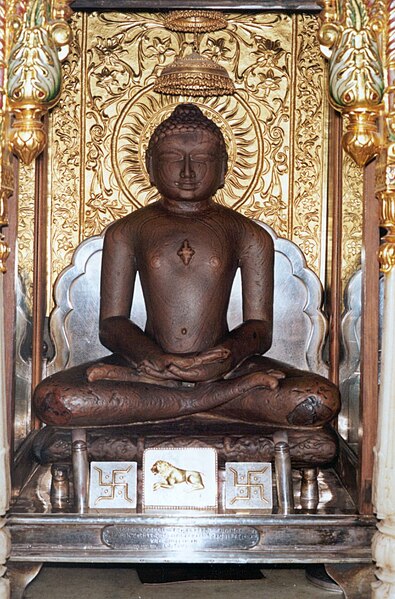Trilokyanatha Temple, also called Thirupparuthikundram Jain temple or Jeenaswamy Trilokyanathar temple, is an 8th-century Digambara Jain temple in Thiruparthikundram, in northeast Kanchipuram in Tamil Nadu, India. The suburb and the area around this temple is also called Jain Kanchi. The stone temple is dedicated to the Jain Tirthankaras, but is notable for integrating Hindu deities with Jain deities within the premises of the temple, particularly as Ksetrapalas. Constructed in Dravidian architecture, the temple was built during the reign of Narasimhavarman II of the Pallava dynasty. The temple was expanded by the Jain community with financial support of Medieval Cholas, later Pallavas and Vijayanagar kings.
Trilokyanatha Temple
The roof top of the three shrines in the temple
Chandraprabha temple built in 8th century
Image: Tiruparuthikundram (2)
Mahavira, also known as Vardhamana, was the 24th Tirthankara of Jainism. He was the spiritual successor of the 23rd Tirthankara Parshvanatha. Mahavira was born in the early 6th century BCE to a royal Jain family of ancient India. His mother's name was Trishala and his father's name was Siddhartha. They were lay devotees of Parshvanatha. Mahavira abandoned all worldly possessions at the age of about 30 and left home in pursuit of spiritual awakening, becoming an ascetic. Mahavira practiced intense meditation and severe austerities for twelve and a half years, after which he attained Kevala Jnana (omniscience). He preached for 30 years and attained moksha (liberation) in the 6th century BCE, although the year varies by sect.
The idol of Tirthankara Mahavira at Shri Mahaveer Ji temple
The birth of Mahavira, from the Kalpa Sūtra (c. 1375–1400 CE)
Murti of Mahavira at his birthplace, Kshatriyakund (Shvetambara tradition), in Bihar
Tirthankar Mahavir giving his half garment to a brahmin as alms








